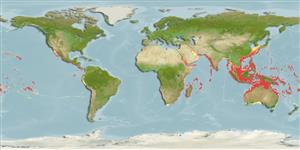Common names from other countries
>
Anguilliformes (Eels and morays) >
Muraenidae (Moray eels) > Muraeninae
Etymology: Gymnothorax: Greek, gymnos = naked + Greek, thorax, -akos = breast (Ref. 45335).
More on author: Rüppell.
Environment: milieu / climate zone / depth range / distribution range
Ecologia
marinhas associadas(os) a recifes; intervalo de profundidade 0 - 150 m (Ref. 1602). Tropical; 35°N - 36°S, 19°E - 77°W
Indo-Pacific: Red Sea and South Africa (Ref. 3257) eastward to the Tuamoto and Austral islands, north to the Ryukyu and Hawaiian islands, south to New Caledonia. Eastern Pacific: Costa Rica, Panama and the Galapagos (Ref. 9324). Southeast Atlantic: South Africa.
Comprimento de primeira maturação / Tamanho / Peso / Idade
Maturity: Lm ?, range 65 - ? cm
Max length : 240 cm TL macho/indeterminado; (Ref. 48635)
Espinhos dorsais (total) : 0; Raios dorsais (total) : 0; Espinhos anais: 0; Raios anais : 0; Vértebras: 132 - 140. Reddish eyes (Ref. 1602). Color yellowish, densely mottled with dark brown; front of head purplish grey; posterior margins of fins yellow-green; gill opening in a black blotch. Juveniles sometimes bright yellow with brown blotches (Ref. 48635).
Along drop-offs (Ref. 48635). Benthic (Ref. 58302). Occurs in coral or rocky areas of reef flats and protected shorelines to seaward reefs. Feeds on cephalopods (Ref. 30573), fishes, and crustaceans (Ref. 89972). Most often appears on the reef after a fish has been speared during daylight. The regularity and promptness of such appearances make it clear that G. flavimarginatus is especially sensitive to stimuli emanating from an injured or stressed fish (Ref. 13550). Eaten in some parts of the Indo-Pacific (Ref. 12484). Minimum depth reported taken from Ref. 128797. Solitary and curious, usually seen with head protruding (Ref 90102).
Ciclo de vida ou comportamento de acasalamento
Maturities | Reprodução | Spawnings | Egg(s) | Fecundities | Larvas
Chen, H.-M., K.-T. Shao and C.T. Chen, 1994. A review of the muraenid eels (Family Muraenidae) from Taiwan with descriptions of twelve new records. Zool. Stud. 33(1):44-64. (Ref. 6934)
Status na Lista Vermelha da UICN (Ref. 130435)
CITES (Ref. 128078)
Not Evaluated
Ameaça para os humanos
Reports of ciguatera poisoning (Ref. 4690)
Uso pelos humanos
Pescarias: espécies comerciais; Aquário: Espécies comerciais
Ferramentas
Relatórios especiais
Baixar XML
Fontes da internet
Estimates based on models
Preferred temperature (Ref.
115969): 23.7 - 29, mean 27.8 (based on 1990 cells).
Índice de diversidade filogenética (Ref.
82804): PD
50 = 0.5000 [Uniqueness, from 0.5 = low to 2.0 = high].
Bayesian length-weight: a=0.00035 (0.00024 - 0.00052), b=3.36 (3.25 - 3.47), in cm Total Length, based on LWR estimates for this species & Genus-body shape (Ref.
93245).
Nível Trófico (Ref.
69278): 4.2 ±0.72 se; based on food items.
Resiliência (Ref.
120179): Muito baixo(a), tempo mínimo de duplicação da população maior que 14 anos (Preliminary K or Fecundity.).
Fishing Vulnerability (Ref.
59153): Very high vulnerability (90 of 100).
